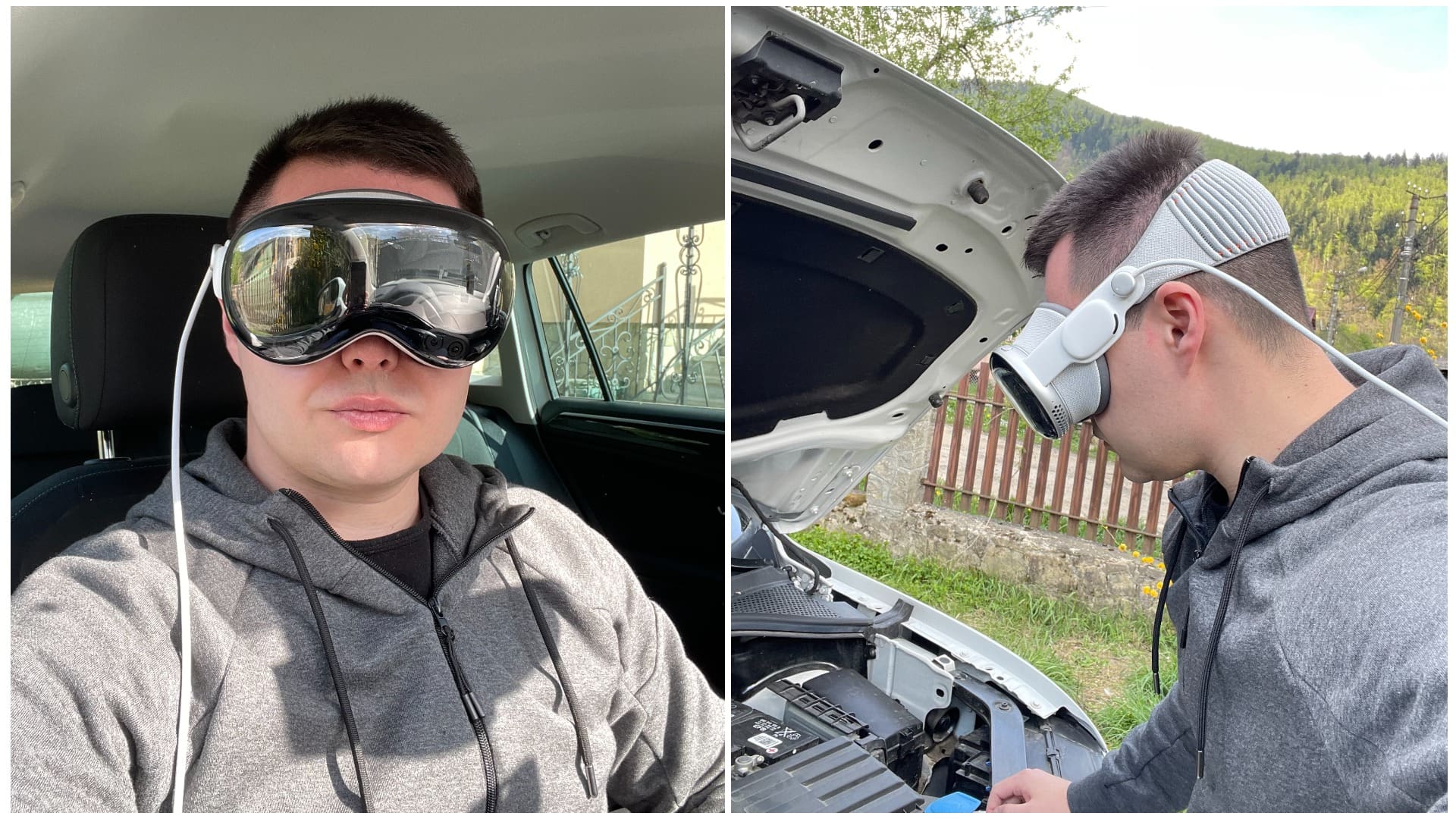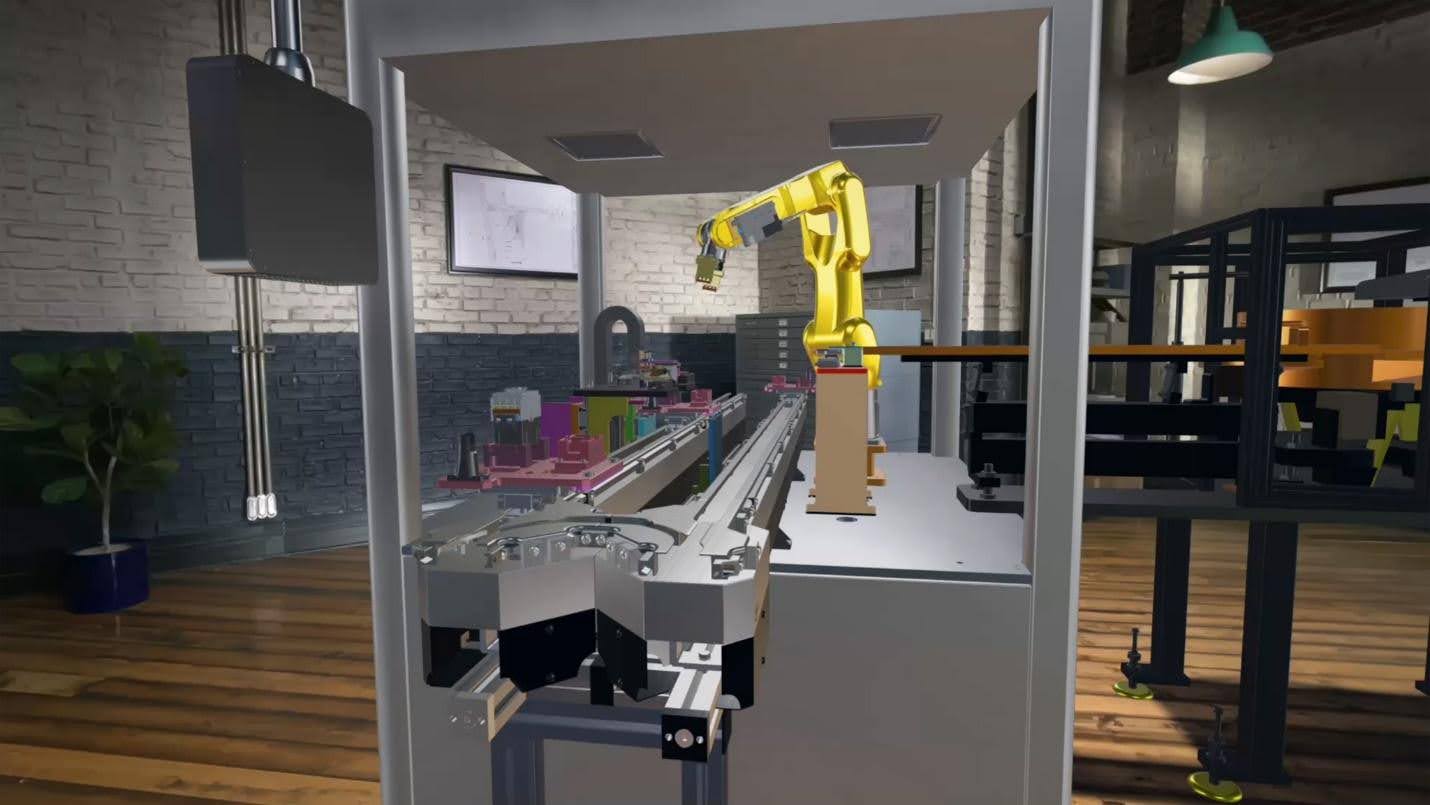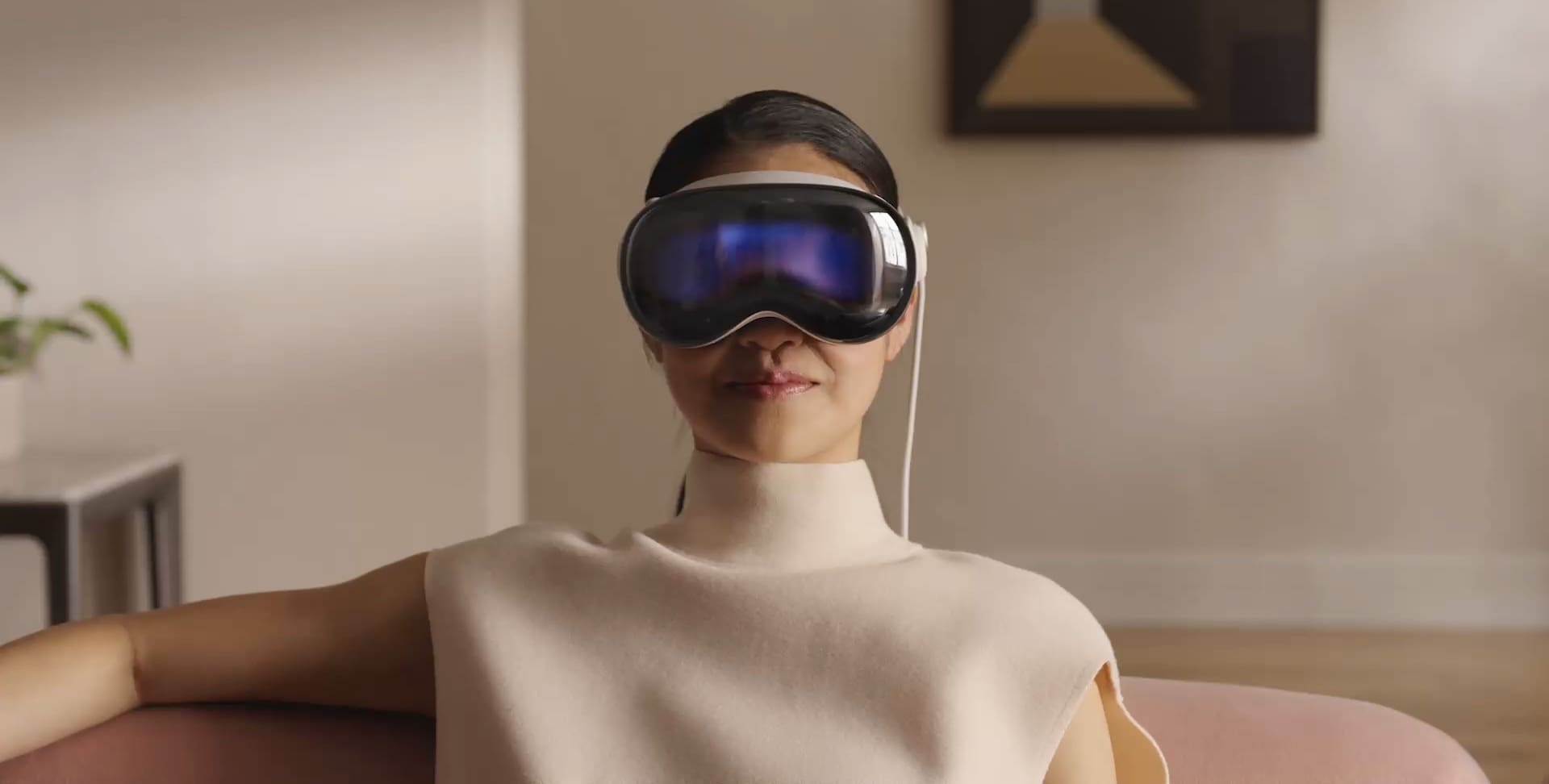After years of speculation, the “Apple Glasses” rumors have finally become a reality. Now that the Apple Vision Pro is on the market, businesses can finally explore Apple’s advanced spatial computing headset.
Whether you have ambitions for consumer-focused, immersive apps or looking to build business-centric experiences on Apple Vision Pro, this development guide will help you succeed.
Apple Vision Pro: Spatial Computing Ecosystem
Similar to its competitors, the Apple Vision Pro features a 3D immersive interface. Instead of flat UI elements, like on traditional devices like phones and laptops, the headset creates interactive 3D menus in front of and around the wearer.
Apple calls this spatial computing, a buzzword clearly intended to transform the meaning of “augmented reality” and “virtual reality” into a more unique vision for the headset’s interface. In fact, both of these terms become interchangeable on the Apple Vision Pro.
At the turn of the digital crown, the user can select between pass through and immersive modes, allowing them to either filter out the real world or see the 3D elements projected over top of it. It’s important to note though, that software on the headset cannot detect which of these two modes the headset is using. This feature is not available to developers, and only the user can see and control it.
The Apple Vision Pro’s most competitive feature is its integration into the existing Apple ecosystem. No other head-mounted display offers the same amount of interoperability with iPhones, MacBooks, and other Apple devices.
Under the Hood: A Quick Feature Overview
Apple’s expensive headset has superior display and input technologies. The Vision Pro is one of the few headsets on the market supporting eye tracking for input, especially as a primary input method.
The Vision Pro’s dual-chip processor makes it one of the most technically capable headsets, giving developers the potential to run more advanced applications and 3D experiences that traditionally would only be possible on desktop hardware.
All of these spatial computing experiences are powered by VisionOS, a new operating system that blends Apple’s signature ecosystem with mixed reality interfaces.
Aside from its powerful ecosystem and high-quality build, some other major selling points that Apple focuses on are:
- Spatial audio: 3D sound processing increases immersion for users
- Multitasking: the ability to run multiple apps and windows at the same time in 3D space can help users be more productive
- Personas: realistic virtual avatars for FaceTime video calls use 3D scans of the wearer’s face
Vision Pro applications can easily be integrated with core programs like Contacts, Calendar, Apple Music, and Siri. This makes it somewhat similar to developing for iPhone or iPad devices. However, you won’t be able to integrate with HealthKit, SMS, and Call Reporting just yet.

Andrew Makarov, Mobile Group Leader and an Augmented Reality Solution Architect at MobiDev, tests the capabilities of Apple Vision Pro
TOP 6 Business Use Cases for Apple Vision Pro
We’ve explored the Apple Vision Pro’s bells and whistles. Let’s dive deeper to see how your business can benefit from the headset in industries like manufacturing, construction, medicine, education, and retail.
1. Real-time Remote Assistance
Getting technical support can be challenging depending on the situation. Video and audio calls for support can be difficult when technicians can’t simply point in 3D space to discuss aspects of a device or other problem. At MobiDev, we have experience in developing AR remote assistance apps for mobile devices, but they are limited by small screens and can’t be used hands-free.
The Apple Vision Pro can take this concept to the next level with head-mounted real-time remote assistance. Since it frees up the user’s hands, it makes technical support much more efficient.

A machine in mixed reality created by PTC, demonstrating the Vision Pro’s ability to simulate complex machines in space.
For example, remote maintenance and complex machine repairs are everyday practice in the manufacturing sector. Technicians often need to inspect and troubleshoot equipment remotely, guiding local staff through repairs and minimizing downtime. US-based computer software and services firm, PTC, has experimented with using the Apple Vision Pro for this purpose, demonstrating that the technology is possible in practice.
2. Remote Collaboration
Just like how remote technical assistance makes virtual support much more efficient, so too can the Apple Vision Pro enhance remote collaboration. Being able to work in a shared, 3D environment is a simple matter with Apple’s new headset, enabling all sorts of team activities like meetings, brainstorming sessions, and presentations.
By emulating physical proximity, remote teams can overcome the isolation that results from distance. It can also make professional development much more accessible, enabling training courses at a lower cost.
3. E-Learning
With the shared experiences that the headset can provide, learning more complex topics can become easier. The Vision Pro’s remote collaboration tools can also make it a much more effective education tool in and of itself. Being able to talk to a teacher in a more immersive space can enable more in-depth conversations and connections than a simple videoconferencing app can.
In addition, the Vision Pro can enable training experiences that wouldn’t be possible otherwise. Another example is a simulation of virtual environments, like factory machinery or other situations that might otherwise be too dangerous to experiment with in real life.
4. Healthcare: Telehealth, Remote Care, Prep, and Training
With doctors already using tools like Microsoft HoloLens for immersive assistance during surgery, the Apple Vision Pro opens up new possibilities for care in the healthcare industry.
Building telemedicine apps for the headset can open up opportunities such as immersive remote care. Data visualization in 3D can also be especially helpful for doctors in many situations. Just like in the earlier manufacturing example, there are also opportunities for immersive surgical simulations for preparation and training.
5. Product Demonstrations
Virtual try-on solutions, enhanced with Vision Pro capabilities, allow customers to explore and interact with products in depth, creating an enriched shopping experience and more informed purchase decisions.
Retailers can build virtual showrooms where customers can view and interact with products right from their homes. Personalized shopping recommendations, combined with an engaging experience, help increase customer satisfaction and increase sales.
6. Real Estate and Construction
Vision Pro by Apple offers an advanced platform for real estate visualization and virtual real estate tours. By virtually walking through the space, customers can explore properties in fascinating detail, thus getting a realistic view of their potential future homes or offices.
Architects can use Vision Pro to enhance interactive architectural planning. In addition, it allows architects and their clients to collaborate in real-time while working on projects.
All of the above use cases are promising, but developers are just beginning to develop Apple Vision Pro applications for real-world business scenarios. We can confidently say that Vision Pro has great potential to significantly enhance companies’ augmented reality strategies and create a completely different level of immersion.
Exploring the Alternatives: Apple Vision Pro vs Meta Quest Pro
When planning the development of a business application for an AR/VR headset, you will probably want to consider alternatives to the Apple Vision Pro platform. Meta Quest Pro and Meta Quest 3 can be considered Apple’s closest competitors in terms of functionality.
| # | Specification | Apple Vision Pro | Meta Quest Pro | Meta Quest 3 |
|---|---|---|---|---|
| 1 | Release Date | February 2nd, 2024 | October 11th, 2022 | October 10th, 2023 |
| 2 | Operating System | visionOS | Modified Android | Modified Android |
| 3 | Display | Micro-OLED 23 million pixels | Dual 1,800 x 1,920 LCD | 2 x LCD |
| 4 | Resolution | 3800 x 3000 per eye | 1800x1920 per eye | 2064x2208 per eye |
| 5 | Refresh Rate | 90Hz, 96Hz, 100Hz | 90 Hz | 120 Hz |
| 6 | Processor | 8-core CPU, 10-core GPU | Snapdragon XR2+ | Snapdragon XR2 Gen 2 |
| 7 | Memory | 16GB unified memory | 12GB RAM | 8GB RAM |
| 8 | Storage | 256GB, 512GB, 1TB | 256GB | 128GB, 512GB |
| 9 | Battery Life | Up to 2.5 hours | 1-5 hours | 2-3 hours |
| 10 | Weight | 600–650 g | 722g | 515g |
| 11 | Connectivity | Wi-Fi 6, Bluetooth 5.3 | Wi-Fi 6E | Wi-Fi 6E |
| 12 | Input | Hands, Eyes, Voice | Hands, eyes, controllers, voice | Hands, controllers, voice |
| 13 | Supported Apps | iOS, iPadOS and MacOS apps, Special Disney+ integrations | Oculus Quest Store apps, Android apps (need modifications) | Oculus Quest Store apps, Android apps (need modifications) |
| 14 | Price | Starting at $3500 | $1000 (256GB) | $499 (128GB) |
For business, there’s no single answer to which headset you should use. It gets even more complicated when you look into what expertise you need to develop for each headset. Meta’s lineup requires Android and Unity experience, while Apple Vision Pro is more closely related to iOS app development.
The Apple Vision Pro’s high price tag is one of the greatest barriers to entry. However, if your business is already deeply entrenched in Apple’s ecosystem, the Vision Pro may be a more cost-effective option compared to building and integrating new enterprise solutions with Android and Meta Quest headsets.
No matter what option you choose, your business will need experienced mixed reality developers like those at MobiDev, who can understand your product goals and elaborate a technical vision for its development.
How to Develop Apps for Apple Vision Pro
There are two ways to develop apps for the Apple Vision Pro: working from scratch or adapting an existing iOS application. Let’s explore each option to understand their pros and cons.
Developing visionOS Apps from Scratch
If you want a clean slate and to take full advantage of the Apple Vision Pro, developing from scratch may be the best option. Although it will be more resource and time-intensive, it ensures the application is fully optimized.
When building Apple Vision Pro apps from scratch, it’s crucial to first create a clear technical vision for your future product. Therefore, it is recommended to start with tech consulting. Having a clear roadmap of development, you can proceed to its implementation.
The visionOS SDK is the backbone of the development process. Apps can have one or more windows and depth can be added using SwiftUI scenes. This allows developers to leverage 3D content using RealityKit, ARKit, and Unity. If developers already have ARKit and iOS development experience, that experience can be easily extended to the Apple Vision Pro.
By default, apps launch into the shared space of visionOS, where apps can run side-by-side. More immersive experiences can be opened in a dedicated Full Space where only that app’s content can appear. With technologies like ARKit, skeletal hand tracking and accessibility features are possible, enabling options for interacting with software using gestures.
Adapting an Existing App to Apple Vision Pro
If you have an existing iOS app that you want to port to Apple Vision Pro, adapting that app can save time and resources, so long as the app already aligns well with mixed reality features. With iOS apps, many of the same UI elements can be reused, as well as application logic like the backend. However, some apps may need more adjustments and testing. For example, apps without SwiftUI will need more updates for the interface.
Apps on Vision Pro will appear larger and more dynamic than their mobile versions. Because of this, there will need to be changes to the interface and overall interaction UX to provide an enjoyable experience.
General Recommendations for Vision Pro App Development
We’ve seen so far, that developing apps for the Apple Vision Pro requires a combination of experiences. Here are the most important takeaways when developing for Apple’s new headset:
- Understand the Vision Pro’s capabilities and limitations: keep in mind the visionOS SDK and the hardware limitations of the device.
- Consider form factor: how can you leverage spatial computing technologies on Apple’s headset to provide value to the user?
- Focus on performance: although the Vision Pro is one of the most powerful headsets out there, it still has technical limitations. Optimize wherever you can.
- Test everything: to focus on the user experience and further optimize your application, test as much of your app as possible.
- Data privacy: pay attention to privacy regulations to protect user data.
- Pay attention to UX: prioritize using simple gestures and interactions that users can easily perform without physical controllers. Avoid incorporating complex actions like typing, which can be difficult on virtual keyboards that rely on hand or eye gestures.
Bring Your Vision to Life with MobiDev
If your ambition is to build experiences for the Apple Vision Pro, you’ll need the right team to help make it happen. Having been involved in augmented reality development since ARKit’s launch in 2017, MobiDev has all the resources you need to succeed.
Client goals are the main focus of our AR application development services. We can become a long-term partner for your ongoing and future projects and support you at any stage of the development process.
If you’re ready to take the next step to stand out in the growing app market for Vision Pro, contact us to discuss your product requirements.




